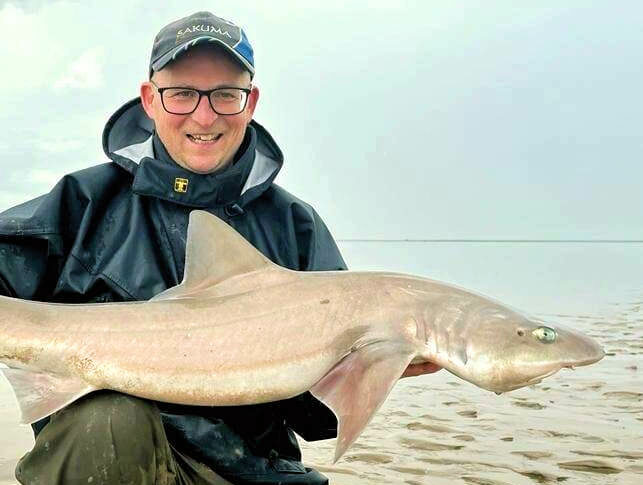Fancy some tips to catch smoothound?

Catching smoothounds in the UK is one of the most exciting and exhilarating experiences that a shore angler can have. These hard-fighting fish are prized for their tenacity and their ability to put up a strong fight, even when they are hooked on relatively light tackle. In this article, we will explore the techniques, strategies, and equipment that are necessary to catch smoothounds from the shore in the UK.
Where to Catch Smoothounds
Smoothounds are found all around the coastline of the British Isles. They are most often caught in the spring and summer months, when they move into shallower water to feed. They are particularly common in estuaries and along sandy beaches, where they can be found feeding on crabs, shellfish, and small fish.
Some of the best venues for catching smoothounds include the beaches and estuaries of South Wales, the South West of England, and the South East of England. Other good areas for smoothound fishing include the North East of England, Northwest coast especially round Morecambe Bay.
Conditions for Catching Smoothounds
The best conditions for smoothound fishing are typically calm, clear water, with a gentle swell. A slack tide or a rising tide is often the best time to fish for smoothounds, as they tend to feed most actively during these periods. Early morning and late evening can also be good times to fish, as this is when smoothounds are often most active.
Rigs for Catching Smoothounds
One of the most effective rigs for catching smoothounds from the shore is the pulley rig. This is a two-hook rig that is designed to hold the bait close to the seabed, where smoothounds are often found feeding. The rig consists of a long leader, a lead weight, two baited hooks, and a swivel at the top to attach the main line.
To make a pulley rig, start by tying a swivel onto the end of the main line. Next, tie a length of shock leader to the swivel. The shock leader should be at least twice the length of the rod and should be made of a strong, abrasion-resistant material. Tie a second swivel onto the other end of the shock leader.
Attach a lead weight to the bottom of the rig using a lead clip or a breakaway lead. The weight should be of a size that matches the strength of your rod and the conditions you are fishing in. A 4-6 oz weight is typically suitable for most smoothound fishing.
Tie two size 3/0 hooks onto the leader using snood knots. The hooks should be spaced about 20 cm apart, with the lower hook positioned close to the lead weight. The bait for smoothounds should be large, smelly, and oily. Some of the best baits for smoothound fishing include peeler crab, squid, mackerel, and sandeels.
Rods for Catching Smoothounds
To catch smoothounds from the shore, you will need a strong, powerful rod that is capable of casting heavy weights and fighting feisty fish. A specialist smoothound rod is the best option, as these rods are specifically designed for this type of fishing.
Look for a rod with a test curve of at least 4-6 oz, a length of 12-14 feet, and a fast action. A high-quality carbon-fibre blank will give you the power and sensitivity you need to hook and land smoothounds.
Bait for Catching Smoothounds
As mentioned earlier, the best bait for catching smoothounds is often large, oily, and smelly. This is because smoothounds have a keen sense of smell and are attracted by strong scents. Some of the best baits for smoothound fishing include peeler crab, lugworms, squid, and mackerel.
Peeler crab is one of the most effective baits for smoothound fishing, as these crustaceans are a favourite food of smoothounds. They are particularly effective when used in combination with other baits, such as squid or mackerel. Lugworms are also a good choice, as they are readily available and are a favourite bait of many sea anglers.
Squid is another popular bait for smoothound fishing, as the scent of this bait can be detected by fish from a long distance. Mackerel fillets are also a good option, as the oily texture and strong scent of these baits can attract smoothounds from a distance.
Handling Smoothound
When handling smoothound, it is important to take care to avoid damaging the fish. These fish are particularly vulnerable when they are caught and landed, and they need to be treated with care to ensure their survival.
When handling smoothound, always use a large, soft landing net/drop net to avoid causing any harm to the fish. Wet your hands before handling the fish and support its body weight as much as possible. If possible, avoid lifting the fish out of the water and use a weigh sling or a measuring mat to record your catch.
Conclusion
Catching smoothounds from the shore is an exciting and challenging experience for any sea angler. By using the right techniques, strategies, and equipment, you can increase your chances of landing these hard-fighting fish. The key to success is to be patient, persistent, and well-prepared, and to always take care to protect the fish that you catch. With practice and experience, you can become a skilled smoothound angler and enjoy some of the best fishing that the UK has to offer.
